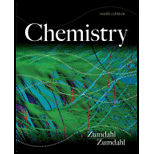
a)
Interpretation: The dissolution of the given following solute and solvent has to be explained.
Concept Introduction: Concept introduction:
Raoult's law:
The mole fraction of a solute is related to the vapor pressure of the solution thus,
a)
Answer to Problem 98AE
Answer
Explanation of Solution
To find the Acetone and water polarity
The electrostatic possible drawing illustrates that acetone (
b)
Interpretation: The dissolution of the given following solute and solvent has to be explained.
Concept Introduction: Concept introduction:
Raoult's law:
The mole fraction of a solute is related to the vapor pressure of the solution thus,
b)
Answer to Problem 98AE
Answer
Explanation of Solution
To find the polarity of
These two molecules are named Ethanol (
c)
Interpretation: The dissolution of the given following solute and solvent has to be explained.
Concept Introduction: Concept introduction:
Raoult's law:
The mole fraction of a solute is related to the vapor pressure of the solution thus,
c)
Answer to Problem 98AE
Answer
Explanation of Solution
To find the polarity of Heptane and Hexane
Heptane and Hexane
Explanation: Because the electrostatic possible diagrams specify, together heptane (
d)
Interpretation: The dissolution of the given following solute and solvent has to be explained.
Concept Introduction: Concept introduction:
Raoult's law:
The mole fraction of a solute is related to the vapor pressure of the solution thus,
d)
Answer to Problem 98AE
Answer
Explanation of Solution
To find the polarity of Methane
This combination represents a non-polar solute in a polar solvent.
Want to see more full solutions like this?
Chapter 11 Solutions
Chemistry
- Carbon tetrachloride (CCl4) and benzene (C6H6) form ideal solutions. Consider an equimolar solution of CCl4 and C6H6 at 25C. The vapor above the solution is collected and condensed. Using the following data, determine the composition in mole fraction of the condensed vapor. Substance Gfo C6H6(l) 124.50 kJ/mol C6H6(g) 129.66 kJ/mol CCI4(l) 65.21 kJ/mol CCI4,(g) 60.59 kJ/molarrow_forwardThe lattice enthalpy of sodium chloride, H for NaCl(s)Na+(g)+Cl(g) is 787 kJ/mol; the heat of solution in making up 1 M NaCl(aq) is +4.0 kJ/mol. From these data, obtain the sum of the heats of hydration of Na+ and Cl. That is obtain the sum of H values for Na+(g)Na+(aq)Cl(g)Cl(aq) If the heat of hydration of Cl is 338 kJ/mol, what is the heat of hydration of Na+?arrow_forwardA gaseous solute dissolves in water. The solution process has H=15 kJ. Its solubility at 22C and 6.00 atm is 0.0300 M. Would you expect the solubility to be greater or less at (a) 22C and 1 atm? (a) 18C and 6 atm? (a) 15C and 10 atm? (a) 35C and 3 atm?arrow_forward
- In terms of Raoults law, distinguish between an ideal liquid-liquid solution and a nonideal liquid-liquid solution. lf a solution is ideal, what is true about Hsoln, T for the solution formation, and the interactive forces within the pure solute and pure solvent as compared to the interactive forces within the solution? Give an example of an ideal solution. Answer the previous two questions for solutions that exhibit either negative or positive deviations from Raoults law.arrow_forwardOnce again, consider Fig. 10-9. Suppose instead of having a nonvolatile solute in the solvent in one beaker, the two beakers contain different volatile liquids. That is, suppose one beaker contains liquid A (Pvap = 50 torr) and the other beaker contains liquid B (Pvap = 100 torr). Explain what happens as time passes. How is this similar to the first case (shown in the figure)? How is it different?arrow_forwardA solvent is known to have a freezing point temperature of 2.5 degree celcius. When a solution is prepared using the same solvent, the freezing point temperature decreases to -4.2 degree celcius. Calculate The change in temperatearrow_forward
- The boiling point of a 1.50 m (molal; moles solute/kg solvent) aqueous solutionof LiI would be expected to bearrow_forwardFreezing point depression can be used to experimentally determine the van 't Hoff factor of a solute in solution. Given the data in the table, answer the questions below and determine the "real" van 't Hoff factor of the solute. Experimental Results Mass of solvent (water) 8.413 g Freezing point of water 0.00°C Freezing point depression constant (Kf) of water 1.86°C/m Mass of solution 9.226 g Freezing point of solution −4.73°C (a) What mass of solute was used? g(b) What is the freezing point depression ΔTf of the solution? °C(c) What is the colligative molality mc of the solution? m(d) How many moles of solute particles are present in solution? mol(e) If the solute has a molar mass of 144.02, what is the van 't Hoff factor i for the solute? (Remember that experimentally, i does not have to be an integer.)arrow_forwardGiven A solution of:...is boiled SOLVENT: Water (H2O) - 100mL or 100.00g SOLUTE: Salt (NaCl) - 11.60g How much is the increase in temperature (in degrees Celsius) computed for the data from this experiment? Note: Answers must be numeric, not alphanumeric—42, not forty-two.arrow_forward
 ChemistryChemistryISBN:9781305957404Author:Steven S. Zumdahl, Susan A. Zumdahl, Donald J. DeCostePublisher:Cengage Learning
ChemistryChemistryISBN:9781305957404Author:Steven S. Zumdahl, Susan A. Zumdahl, Donald J. DeCostePublisher:Cengage Learning
 Chemistry: An Atoms First ApproachChemistryISBN:9781305079243Author:Steven S. Zumdahl, Susan A. ZumdahlPublisher:Cengage Learning
Chemistry: An Atoms First ApproachChemistryISBN:9781305079243Author:Steven S. Zumdahl, Susan A. ZumdahlPublisher:Cengage Learning Chemistry: Principles and ReactionsChemistryISBN:9781305079373Author:William L. Masterton, Cecile N. HurleyPublisher:Cengage LearningChemistry: Matter and ChangeChemistryISBN:9780078746376Author:Dinah Zike, Laurel Dingrando, Nicholas Hainen, Cheryl WistromPublisher:Glencoe/McGraw-Hill School Pub Co
Chemistry: Principles and ReactionsChemistryISBN:9781305079373Author:William L. Masterton, Cecile N. HurleyPublisher:Cengage LearningChemistry: Matter and ChangeChemistryISBN:9780078746376Author:Dinah Zike, Laurel Dingrando, Nicholas Hainen, Cheryl WistromPublisher:Glencoe/McGraw-Hill School Pub Co Principles of Modern ChemistryChemistryISBN:9781305079113Author:David W. Oxtoby, H. Pat Gillis, Laurie J. ButlerPublisher:Cengage Learning
Principles of Modern ChemistryChemistryISBN:9781305079113Author:David W. Oxtoby, H. Pat Gillis, Laurie J. ButlerPublisher:Cengage Learning





